.
Spechteln am Wochenende machte mit Sonnenfleck-2192-Beobachtung am Tage durch auflösende Nebelbänke viel Spaß.
.
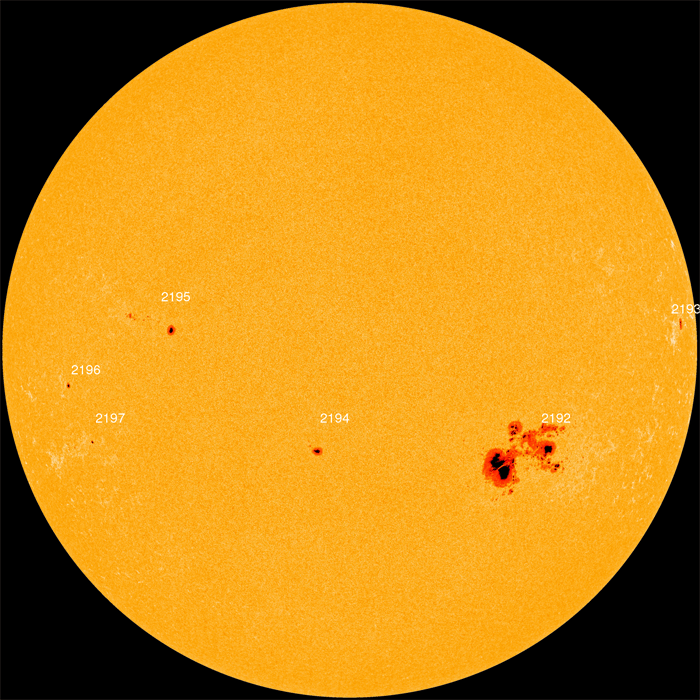
So sieht NASA-Sonde SoHo die aktuellen Sonnenflecken auf der Sonne...
und nachfolgende Aufnahmen vom Beobachten durch Nebelbank als Filter:
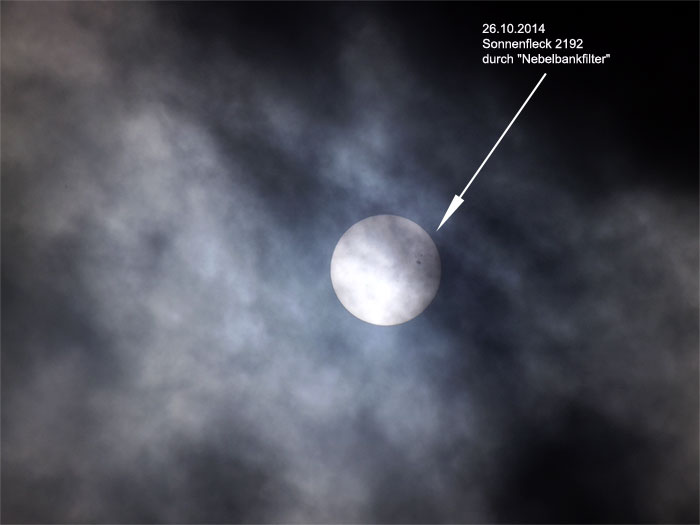
.
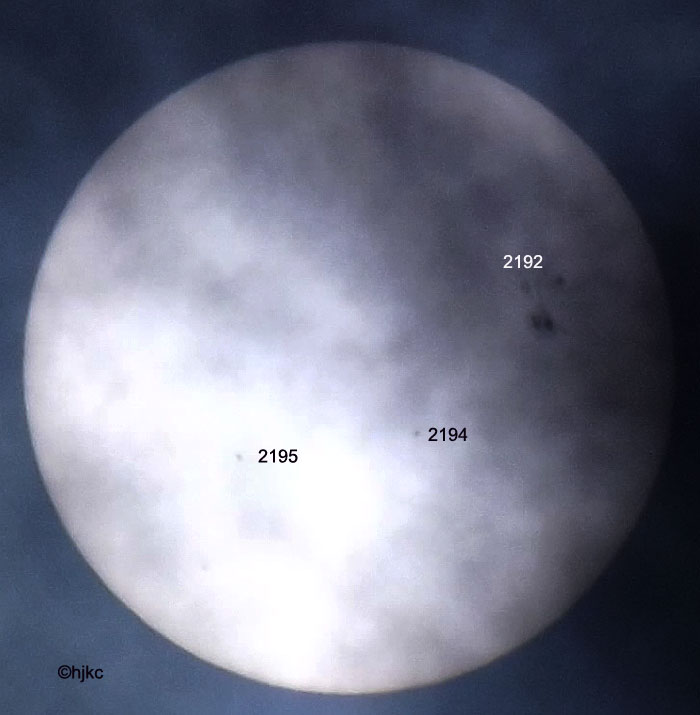
.
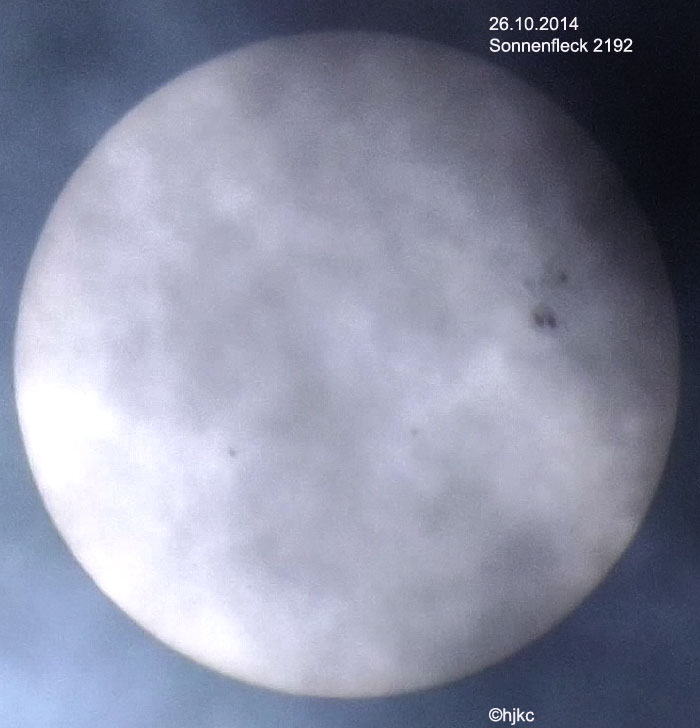
.
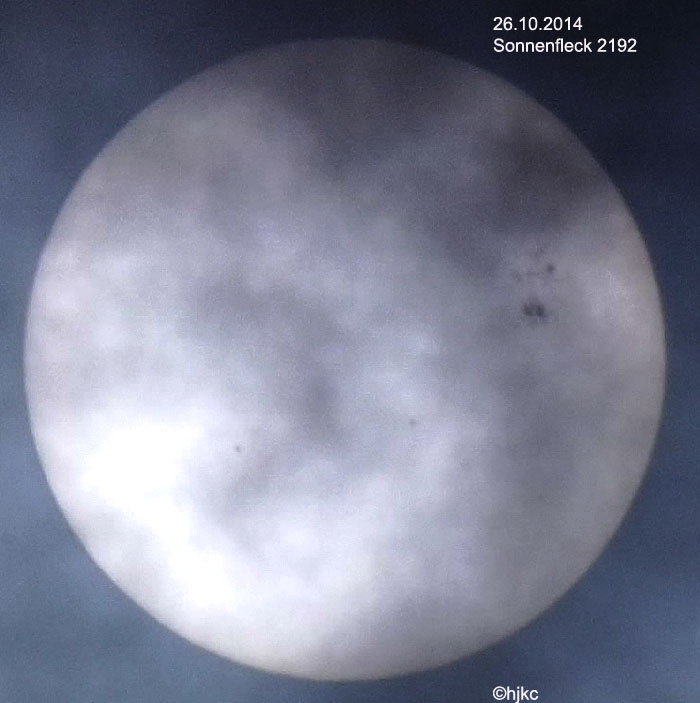
.
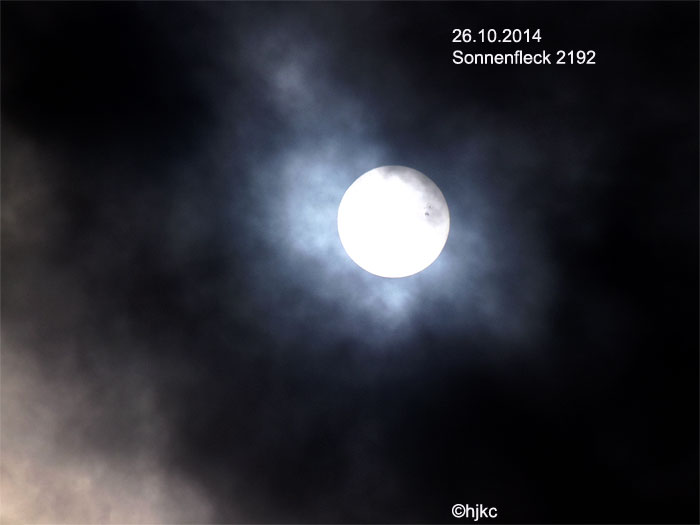
.
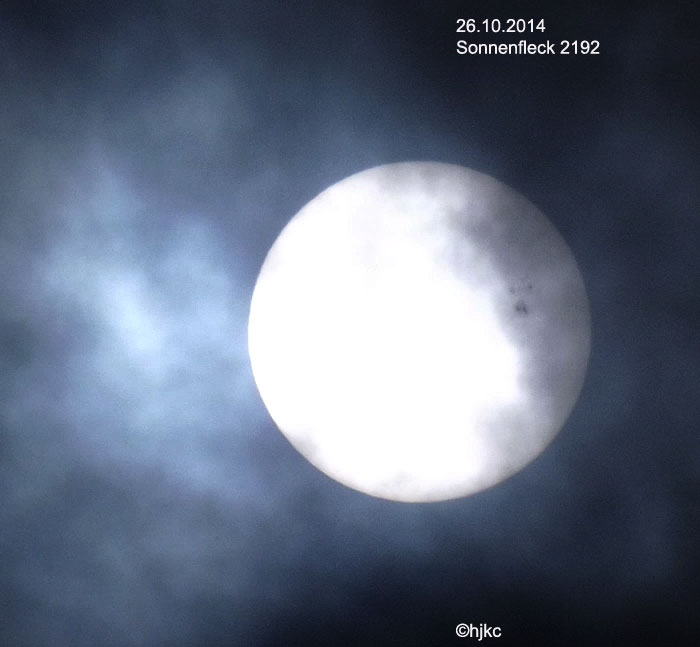
.
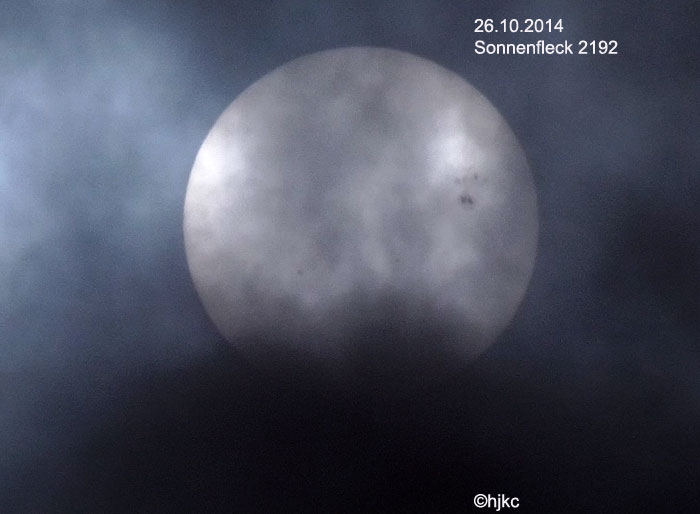
.
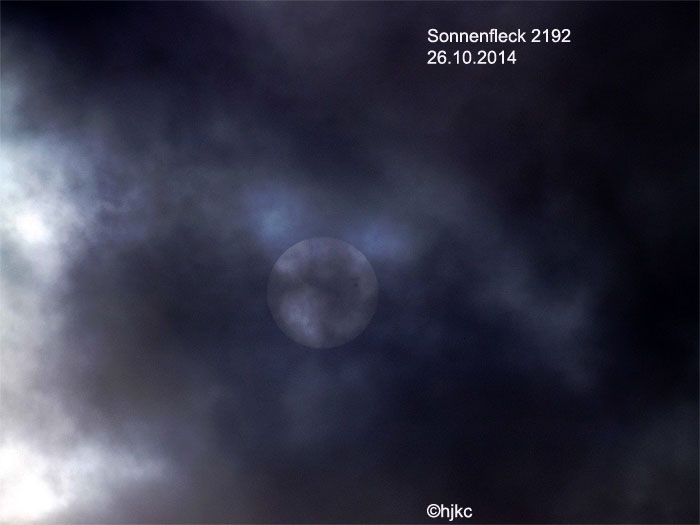
Fotos: @hjkc
.
Update:
GIANT SUNSPOT CRACKLING WITH FLARES: AR2192 is the biggest sunspot in nearly 25 years, and it is still growing. The active region now covers 2750 millionths of the solar disk, an area equivalent to more than 16 planet Earths skinned and spread out flat. It is so large that sky watchers are seeing it with the naked eye when the sun is dimmed by low-hanging clouds or, in this case, dense fog:
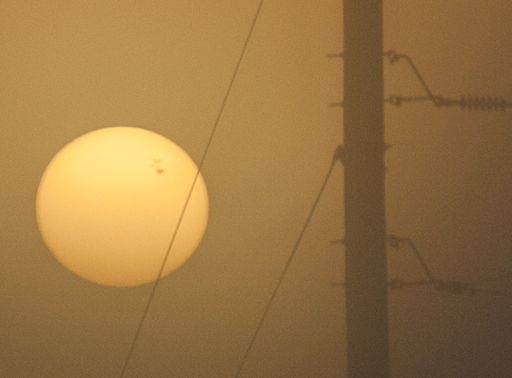
Barry Freas took the picture on October 26th from Red Hill, Kentucky. "It was a very foggy morning," he says. "AR2192 was remarkable."
Big sunspots tend to produce strong flares, and AR2192 is no exception. It is crackling with magnetic activity. Since the active region appeared on Oct. 19th it has unleashed 5 X-flares and a dozen M-flares. The most intense of these flares have caused HF radio blackouts and other communication disturbances on the dayside of Earth.
Usually, strong flares are accompanied by massive CMEs--billion-ton clouds of electrified gas that billow away from the blast site. So far, however, none of the eruptions from AR2192 has produced a major CME. Without a series of CMEs to hit Earth and rattle our planet's magnetic field, there have been no geomagnetic storms nor any widespread auroras.
Quelle: Spaceweather
.
Update: 1.11.2014
.
Tracking a Gigantic Sunspot Across the Sun
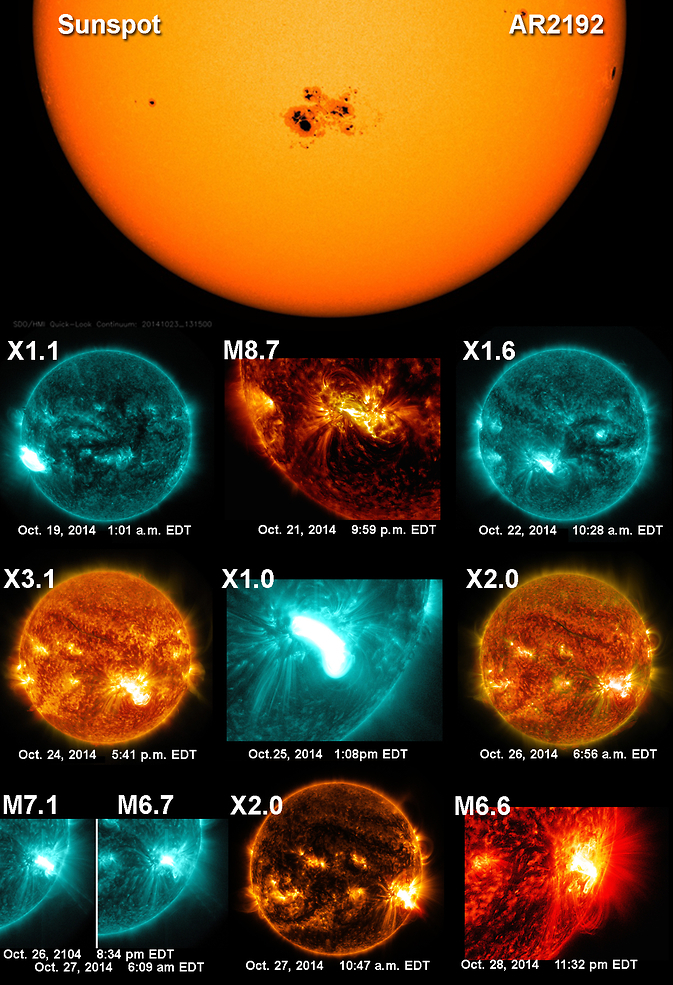
Super sunspot AR2192 produced 10 significant solar flare while traversing the Earth-side of the sun; six X-class and four above M5-class.
Image Credit: NASA/SDO
.
An active region on the sun – an area of intense and complex magnetic fields – rotated into view on Oct. 18, 2014. Labeled AR 12192, it soon grew into the largest such region in 24 years, and fired off 10 sizable solar flares as it traversed across the face of the sun. The region was so large it could be seen without a telescope for those looking at the sun with eclipse glasses, as many did during a partial eclipse of the sun on Oct. 23.
"Despite all the flares, this region did not produce any significant coronal mass ejections," said Alex Young a solar scientist at NASA's Goddard Space Flight Center in Greenbelt, Maryland. Coronal mass ejections, or CMEs, are giant clouds of solar particles that can affect technology when they reach near-Earth space. "You certainly can have flares without CMEs and vice versa, but most big flares do have CMEs. So we're learning that a big active region doesn't always equal the biggest events."
Such active regions are measured in millionths of a solar hemisphere, where 1 micro-hemisphere, or MH, is about 600,000 square miles. This region topped out at 2,750 MH, making it the 33rd largest region out of approximately 32,000 active regions that have been tracked and measured since 1874. It is the largest sunspot seen since AR 6368, which measured 3,080 MH on Nov. 18, 1990.
The largest five active regions ever observed were between 4,000 and more than 6,000 MH and they all appeared between 1946 and 1951.
On the other hand, the region that produced one of the biggest solar flares of all time on Sep. 1, 1859 – in what's known as the Carrington event – wasn't even one of the top 50 at only 2,300 MH.
During its trip across the front of the sun, AR 12192 produced six X-class flares, which are the largest flares, and four strong M-class flares. M-class flares are one tenth as strong as X-class flares. The number provides more information about its strength. An M2 is twice as intense as an M1, an M3 is three times as intense, etc.
"Having so many similar flares from the same active region will be a nice case study for people who work on predicting solar flares," said Dean Pesnell, project scientist for NASA's Solar Dynamics Observatory at Goddard. "This is important for one day improving the nation's ability to forecast space weather and protect technology and astronauts in space."
The DATES and peak times in EDT of the large solar flares from AR 12192 are as follows:
Oct. 19, 1:01 am: X1.1
Oct. 21, 9:59 pm: M8.7
Oct. 22, 10:28 am: X1.6
Oct. 24, 5:41 pm: X3.1
Oct. 25, 1:08 pm: X1.0
Oct. 26, 6:56 am: X2.0
Oct. 26, 8:34 pm: M7.1
Oct. 27, 6:09 am: M6.7
Oct. 27, 10:47 am: X2.0
Oct. 28, 11:32 pm: M6.6
AR 12192 rotated onto the far side of the sun on Oct. 30, 2014, however as it evolves, we may see a new version of it rotating back into view in two weeks.
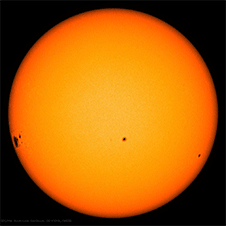
The largest sunspot since November 1990 is seen traveling across the front of the sun in these images from NASA's SDO, captured Oct. 17-Oct 29, 2014.
Image Credit: NASA/SDO
Quelle: NASA
4542 Views
